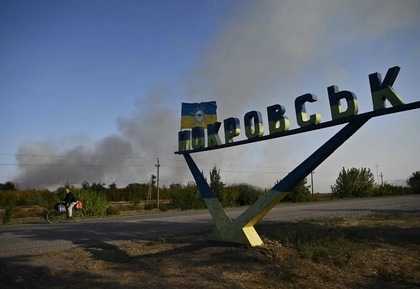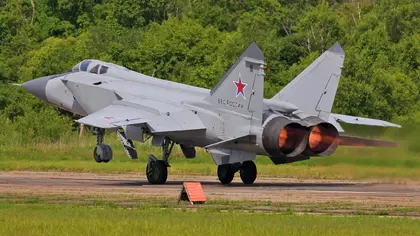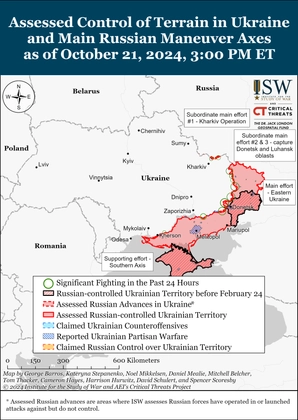Russia has forward deployed the MiG-31 to a base in Crimea to facilitate launching patrols over the Black Sea on what Putin claims will be nearly permanent patrols to threaten all of Ukraine with Kinzhal missiles.
These aircraft are carriers for Kinzhal hypersonic missiles and, according to the Russians, using them to patrol the Black Sea will allow them to “destroy Ukrainian HIMARS.”
JOIN US ON TELEGRAM
Follow our coverage of the war on the @Kyivpost_official.
But is it the sole purpose of having these aircraft in the air?
The thing is that the MiG-31 has two different configurations: the MiG-31K, a Russian Kinzhal carrier, and the MiG-31BM – an interceptor aircraft armed with R-37M air-to-air missiles capable of bringing down air targets at distances of up to 300 kilometers.
The Russians have already transferred some MiG-31s to the Belbek airport in Crimea. As per satellite images, it remains unclear which type of MiG-31 is located on the airfield.
So, it is likely that the Russians will employ the MiG-31 not only to attack Ukraine but also to protect their military facilities from Ukrainian missiles like Neptune, Storm Shadow/SCALP and ATACMS.
In any case, the takeoff of the MiG-31 will be accompanied by an air-raid alert on the whole territory of Ukraine. The Russians aim to escalate the tension and put additional pressure on Ukrainians with this constant state of “danger.”
Ukrainian Air Force spokesperson Yuriy Ihnat said the new Russian threats won’t make things much different. “The new statement from Russia won’t change a thing for Ukraine. The enemy is already threatening our country with various weapons every day. So maybe it is the press secretary of the demented dictator who should comment on his statements.

Frontline Ukraine Cafe Offers Glimpse of Normality as War Rages
From a technical point of view, the characteristics of the Kh-47 Kinzhal aeroballistic missile allow Russia to launch it on Ukrainian territory both from northern and eastern directions.
So, the Black Sea water area is just yet another direction. Besides, Russian aviation already patrols the airspace there with fighter jets and scouts,” he summed up.
MiG-31
The MiG-31 is a Soviet all-weather supersonic interceptor aircraft. It has been in service since 1981. This jet was developed as an ideological and technological continuation of its predecessor – the MiG-25.
During the development of the MiG-31, the requirements for the jet remained the same as during the creation of the MiG-25. The updated aircraft can intercept air threats at any altitude – ultra-low, medium, and high, regardless of weather conditions or radar interference.
The updated radar in the MiG-31BM “Zaslon-M” can detect targets with a radar cross-section (RCS) of 20 m² at up to 400 kilometers. For smaller targets with an RCS of 5 m² [There are no current Western fighter (and nearly all bomber) aircraft with this big an RCS, including the F-16 – ed.], this detection range is around 280 kilometers.
Combined with the newer R-37M air-to-air missiles, the MiG-31BM can shoot down aircraft from up to 300 kilometers if the target is flying toward it [and doesn’t maneuver at all – ed.].
Why the MiG-31?
Russia chose the MiG-31 as the delivery vehicle for the Kinzhal due to its impressive altitude and speed characteristics. Two powerful engines allow this fighter to develop a speed almost three times greater than the speed of sound – 2.8 Mach or 2,956 kilometers per hour above 12 km (40,000 feet) of altitude.
The service ceiling of the MiG-31 is 21,500 meters (70,000 feet). A high maximum speed and altitude are necessary during its launch to provide the missile with its advertised performance.
Altitude and speed are critical for a missile of this type, so it doesn't have to spend fuel on acceleration and altitude gain.
Thus, the Kremlin’s declared range of the Kinzhal missile is 2,000 kilometers, which would be sufficient to strike the entire territory of Ukraine from any current launch location utilized by Russia.
The load capacity indicator is also crucial. The MiG-31 can carry up to 9 tons of total payload on its pylon stations. The Kh-47 M2 Kinzhal weighs 4.3 tons.
However, the MiG-31 can carry only one Kinzhal at a time based on its pylon limits – while equipped with this missile, it can’t carry other weapons. It’s also believed that all Kh-47 carriers are made as light as possible by reducing the amount of equipment on board.
Russian propagandists claim that Russia managed to convert the Su-34 to be compatible with the Kinzhal, but such claims seem highly dubious. Thus, the Su-34 has a carrying capacity of 8 tons; however, if it takes off with a full fuel tank [as military aircraft almost always do – ed.], this capacity drops to 4 tons, which is no longer enough to accommodate the Kinzhal aboard.
Besides, to launch this missile, a launch speed of about 3,000 km/h is desired, while the maximum speed of the Su-34 is 1,900 km/h.
Kh-47M2 Kinzhal
The Russians call the Kinzhal an aviation missile system because it is used in tandem with the MiG-31K fighter. The Kh-47M2 is, in fact, a slightly lower payload derivative of the Iskander ground-based missile. This is reflected in certain visual similarities and the fact that these missiles are manufactured at the same factory.
However, the declared characteristics of Kinzhal should be taken with a grain of salt since almost all the information about it comes from the Russian mass media. So, the specifications may be overstated.
Russian mass media claim that the maximum speed of Kinzhal when approaching the target is close to 15,000 km/h, and the speed at a cruising altitude of 20 kilometers is about 11,500 km/h.
Ukrainian Air Force spokesperson Yuriy Ihnat confirmed the missile is moving at a very high speed – over 7,000 km/h.
"The air defense of Ukraine has already taken down 14 Kinzhal missiles. Counting in over 20 downed ballistic missiles (including Iskanders and S-400), we are getting impressive statistics.
The Kinzhal moves through the atmosphere at an incredible speed, more than 7 thousand kilometers per hour, so the reaction time is scarce," he emphasized.
The Kinzhal missile is more of an aeroballistic missile than a ballistic one. The main difference is that the trajectory of an aeroballistic missiles is lower than that of ballistic ones [which follow a parabolic flightpath using gravity].
Shooting down such missiles is sometimes even trickier since they don’t just soar to a significant height and crash into the target. Aeroballistic missiles maneuver and change altitude, which hinders the anti-missile operation by being unpredictable.
The missile is launched from the air, which allows for a more efficient use of fuel. At the same time, the MiG-31K works as the first stage of the rocket. It brings the missile to an altitude of 15 kilometers and supposedly accelerates it to 3000 km/h.
Then, it rises to about 20 kilometers (65,000 feet) altitude and gains hypersonic speed. At the final point of the flight, the Kh-47 captures the target and heads towards the ground at an impact angle close to 90 degrees.
Ukraine requires advanced anti-missile defense systems, namely the US Patriot, to effectively intercept and neutralize these incoming missiles.
The spokesperson for the Ukrainian Air Force, Yuriy Ihnat, has reported that they have successfully shot down 14 Kinzhal and 20 Iskander missiles using this system.
You can also highlight the text and press Ctrl + Enter






